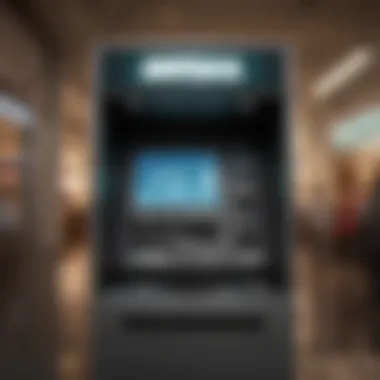Understanding Cardtronics ATM Fees: A Detailed Guide


Intro
Navigating the world of ATMs can be as confounding as a maze. One name that frequently pops up in these discussions is Cardtronics. While many users appreciate the convenience of ATMs, the fees tied to their use can feel like a burden. Understanding what these charges mean and how they stack up against alternatives is crucial for consumers.
This article unpacks the nuances of Cardtronics ATM fees, diving deep into how they impact your wallet. By shedding light on their structure, consumer implications, and comparing them to competitors, we aim to offer the kind of clarity that empowers users to make well-informed banking choices. Whether you're a casual ATM user, a consistent cash withdrawal warrior, or someone who navigates complex financial waters, having a grasp on these fees is essential.
As we wade through the depths of the ATM landscape, you'll also glean insights on ways to potentially minimize these costs through smart financial practices and user experiences. It's all about education and proactivity—understanding these fees isn't just beneficial; it's crucial for anyone hoping to manage their finances effectively. Let's embark on this journey to demystify ATM fees.
Preface to Cardtronics ATM Services
Understanding the nuances of ATM service providers is an essential aspect for anyone looking to enhance their financial literacy. Cardtronics stands out as a significant player in this landscape, operating a vast network of ATMs across numerous locations. In this part of the article, we will take a closer look at why understanding Cardtronics ATM offerings is crucial for consumers. Knowing how these services operate can empower individuals to make wise and informed financial choices.
Overview of Cardtronics
Cardtronics, a prominent provider of ATM services, operates thousands of automated teller machines across the United States and other countries. These machines are a lifeline for many bank customers who may not have easy access to their home bank's ATMs while on the move. The strength of Cardtronics lies in its extensive reach, often found not only in bank branches but also in retail locations, convenience stores, and gas stations. The sheer number of machines ensures that cash is often just a short walk away for users.
Cardtronics also collaborates with various financial institutions, enabling non-customers the option to withdraw cash conveniently without stepping foot into traditional bank premises. This collaborative model provides real benefits, especially for individuals who are constantly on the go and may require access to cash outside of bank operating hours. However, navigating this vast network does come with its own set of challenges, particularly regarding the fees associated with using these ATMs.
Importance of Understanding ATM Fees
Understanding ATM fees is no small matter; it can significantly impact your financial health. When you decide to use a Cardtronics ATM, it’s essential to be aware of the costs involved. Not only can transaction fees eat away at your withdrawals, but other charges may apply as well. It can sometimes feel like you are getting hit from all sides, especially when using machines outside your bank’s network.
Apart from merely recognizing what fees you might incur, comprehending their implications can help sharpen your budgeting skills and improve your overall financial strategy. For example, engaging fully with your ATM usage, such as aiming to use ATMs within your bank's network or being cautious about currency conversion fees when abroad, can lead to improved savings down the road.
By taking the time to learn about the fee structures, customers can avoid those pesky hidden costs that often catch people off guard. As we delve further into the workings of Cardtronics ATMs, we’ll dissect the fee structures, types of fees, and ways to mitigate these costs, ensuring that readers navigate this aspect of their finances with their eyes wide open.
Breakdown of Cardtronics ATM Fees
The landscape of automated teller machine (ATM) fees is intricate, and understanding it is paramount for anyone relying on ATMs regularly. Breakdown of Cardtronics ATM Fees aims to shed light on the various fees associated with using these machines, empowering consumers to make informed choices. With a rising number of transactions occurring at these points, knowing the fee structures can have significant financial implications.
Fee Structure Overview
A clear understanding of the fee structure is like having a roadmap. Knowing where your money oozes out can lead to better financial management. Cardtronics, as a leading ATM provider, employs a nuanced fee structure that varies based on the type of transaction, location, and the user’s banking affiliations.
Cardtronics’ ATM fees range from convenience fees, which are charged to the user, to surcharges that banks impose. For instance, if you’re swiping your card at a third-party ATM, you may encounter both a transaction fee from Cardtronics and an additional fee from your bank. This layering can crowd your pocketbooks if you’re not observant.
Understanding this structure isn’t just about dodging unnecessary fees; it’s also about strategizing withdrawals. Many users might be unaware of better alternatives, often leading to loaded costs. Hence, becoming familiar with this framework enhances financial awareness.
Types of Fees Associated with Withdrawals
When delving deeper into the realm of fees, it’s essential to break down the types that frequently come up when making withdrawals at Cardtronics ATMs:
Transaction Fees


Transaction fees are perhaps the most well-known in the ATM environment. Typically, these fees are imposed whenever a user opts to take out cash from an ATM that does not belong to their bank's network. The key characteristic here is transparency; these fees are generally displayed on the ATM screen prior to the transaction.
In many cases, transaction fees hover around a few dollars, depending on the ATM’s location and Cardtronics’ specific pricing agreements. While it may seem like a trivial amount in isolation, these fees can accumulate quickly if users make frequent withdrawals. This feature is essential because it can lead individuals to rethink their withdrawal habits and consider alternatives.
While some people may consider transaction fees a necessary evil, it’s crucial to recognize their impact on one’s budget. By understanding these charges, it becomes easier to align ATM use with one�’s financial strategy.
Currency Conversion Fees
When making withdrawals abroad, currency conversion fees take center stage. These fees come into play when a user withdraws cash in a foreign currency. The bank or ATM operator applies a rate that varies from the market rate, adding an extra layer of cost to ATM transactions.
One unique feature of currency conversion fees is that they often go unnoticed by casual travelers. Without a thorough understanding of these charges, clients might find themselves feeling the pinch after returning from a trip. Additionally, the notion of hidden fees stings deeper when travelers are counting their pennies.
It’s advisable to inquire beforehand or even check online to see if certain banks offer friendlier rates, ultimately giving consumers better tools to handle their finances while abroad.
Balance Inquiry Fees
Last but not least, balance inquiry fees. When users check their account balances at ATMs, Cardtronics may charge a fee for this service. Although this fee is often lower than withdrawal fees, it can add up if conducted frequently.
This service’s key characteristic involves instantaneity; users can quickly check their account status without stepping into a bank branch. However, this ease comes at a cost, and some users may discover that using a mobile banking application for balance checks is more cost-effective, avoiding unnecessary fees at ATMs altogether.
On one hand, balance inquiry fees might seem negligible at first glance. Nevertheless, they can accumulate across multiple visits, leading to potential overspending without conscious awareness. Thus, understanding these minimal charges helps users remain vigilant about their overall banking activities.
"Navigating ATM fees can feel like walking through a minefield, but with a little knowledge, you can dance around the costs!"
By examining transaction fees, currency conversion fees, and balance inquiry fees, it's evident that each type brings its own benefits and downsides, impacting the overall experience of using Cardtronics ATMs. For consumers, delving deep into these fee structures opens opportunities to save and strategize more effectively.
Comparison with Other ATM Providers
Understanding how Cardtronics ATM fees stack up against other providers is crucial for consumers keen on maximizing their banking experience. It’s not just about the fees themselves; it’s also about knowing what you get for what you pay. In a competitive market, consumers have options, and weighing these choices can lead to more informed financial decisions. This section digs deeper into the competitive ATM landscape, helping you understand the landscape better and make wiser choices.
Competitive Landscape
The ATM landscape isn’t one-size-fits-all; context matters. Cardtronics operates a wide network, often placing devices in locations where traditional banks don't have a physical presence. This can be especially useful for people in rural areas or locations with fewer banks. However, it also means differing fees that can vary not only from bank to bank but machine to machine.
With the growing reliance on digital banking and mobile transactions, many independent operators also enter the fray, offering varied fee structures. Some offer free withdrawals for certain cards, while others charge a premium. Understanding where the fees lay and what’s included is essential in not just comparing costs but comprehending the value received.
Fee Comparison Analysis
Big Banks vs. Cardtronics
When comparing Big Banks with Cardtronics, it’s hard to overlook the sheer size and customer base that larger banks possess. They often tout a larger network of ATMs with no fees for account holders. However, the catch is that their ATM networks may not always be conveniently located, especially in less populated areas. The key characteristic here lies in accessibility versus cost — Big Banks frequently offer free withdrawals, but only if you have an account with them. On the other hand, Cardtronics often provides wider access in less conventional locations, which could be beneficial in an emergency.
A unique feature of Cardtronics is its focus on convenience, sometimes charging fees but offering the ability to withdraw cash when traditional banks might not be available. This can be particularly advantageous during off-hours or in places like festivals or events where cash might be required. In essence, while Big Banks may offer minimal fees for their users, Cardtronics adds a layer of accessibility that can be a game-changer in certain situations, though this often comes at a cost.
Fee Structures of Independent ATMs


Moving on to the Fee Structures of Independent ATMs, these can be quite the mixed bag. Some independent ATMs do not require monthly fees at all and charge only when cash is withdrawn. Their key characteristic often revolves around the niche placements, such as in cafes or convenience stores, targeting specific demographics who might need cash quickly while shopping.
These machines can offer significantly lower fees compared to others. However, their reliability can be inconsistent. If you depend on having knowledge of which independent ATMs don't charge or offer the best rates, that can be cumbersome. A unique aspect of these machines is they sometimes collaborate with customer loyalty programs, allowing users to avoid fees entirely by using a specific card. This could serve both as an advantage and a disadvantage, depending on how many cards you carry.
"With a little research, you can turn the tables on ATM fees and steer clear of unnecessary costs."
The overarching takeaway here is to evaluate not just the fees but the totality of the service — convenience, reliability, availability, and your own banking habits. In the end, knowledge truly is power, and understanding the differences between what Cardtronics offers compared to other ATM providers can pave the way towards better financial health.
User Experiences and Testimonials
Understanding Cardtronics ATM fees is not just about the numbers; user experiences provide a vital narrative that sheds light on the real impact these fees have on customers. This section focuses on how real-world experiences help inform potential users about what to expect when using Cardtronics ATMs. From anecdotal evidence to statistically significant cases, user testimonials can offer insights into whether these fees are justified or excessive. The testimony of frequent users can often reveal nuances that a simple fee breakdown cannot convey, such as convenience factors, service quality, and overall satisfaction with the ATM usage experience.
Case Studies of Frequent Users
Consider the experience of Jill, a frequent traveler who utilizes Cardtronics ATMs while on the go. Jill often finds herself in remote areas where traditional bank branches are few and far between. For her, convenience outweighs the extra fees she sometimes incurs. "I remember needing cash for a street fair in South Carolina. The nearest ATM was Cardtronics. Yes, it charged a fee, but it saved me the hassle of driving miles to find a bank. In the grand scheme of things, I’d pay a little extra for that peace of mind," she recounts.
Similarly, Frank, who works in a bustling urban environment, chooses Cardtronics over his bank's ATMs because of their accessibility. "I might pay a couple of dollars at Cardtronics, but during my busy day, it’s worth it to avoid detours. Time is money!" his words echo a common sentiment.
These case studies underline the importance of context when evaluating whether ATM fees are worthwhile; what seems excessive to one may be a small price for convenience to another.
Common Complaints and Praise
Despite positive experiences, many users have voiced complaints about Cardtronics ATM fees. A common frustration revolves around the lack of transparency regarding fees. One user on Reddit pointed out, “Sometimes I don’t know what I’m paying until I see it deducted from my account. It’s frustrating!” This sentiment highlights a key area of concern.
Alternately, there is also a wealth of praise regarding the customer service associated with Cardtronics ATMs. People like Maria complement the quick transaction times and user-friendly interfaces. "I appreciate that I can quickly select my options and get my cash in no time. The service is generally reliable," Maria notes.
In summary, understanding the experiences of current users can be illuminating for prospective customers. Complaints and praises alike reveal not just satisfaction levels, but also the importance of evaluating ATM services through the lens of personal experience.
"User feedback is invaluable; it transforms numbers into relatable stories that resonate with potential customers."
Strategies to Minimize ATM Fees
Navigating the complex landscape of ATM fees can feel like walking through a minefield, especially when unexpected charges pop up at the most inconvenient times. In this section, we will delve into the strategies that help individuals keep their hands from being burned by exorbitant fees. The key to minimizing these costs lies in being informed and making strategic choices while accessing your cash.
Choosing the Right ATM
When it comes to ATM usage, selecting the right machine can make a world of difference. Understanding the fee structures of various ATM providers is crucial. Generally, Cardtronics ATMs may have different fees compared to banks or independent operators. Here are some tips to consider:
- Location Matters: ATMs situated in convenience stores or gas stations tend to charge higher fees. Using ATMs in bank branches usually result in lower or no fees.
- Network Participation: Check if your bank has a partnership with an ATM network. For instance, using an ATM that is part of the Allpoint Network can often save you from fees.
- Fee Display: Always look for the fee alert on screen before completing your transaction. Many ATMs will inform you of any charge prior to withdrawal. This allows you to back out if the fee seems outrageous.
Being vigilant about the ATM you choose not only saves you money but can also facilitate smoother, more efficient transactions.
Using Bank Networks to Avoid Fees
In today's financial climate, leveraging your bank's network has emerged as a practical approach to sidestep pesky ATM fees. Many banks have established partnerships with series of ATMs where users can withdraw cash without incurring fees. Here’s how to effectively utilize these networks:


- Research Your Bank's Network: Familiarize yourself with your bank's ATM locations. Websites often have maps showing nearby machines where fees are waived.
- Mobile Apps: Utilize banking apps that feature ATM locators. These apps often highlight fee-free options in real-time and can pinpoint the closest location.
- Inter-bank Agreements: Some banks allow their customers to use other banks’ ATMs at no cost. Always check with your financial institution to see if such agreements exist.
Success in reducing ATM fees could simply be a matter of knowing where to go.
Cash Management Tips
Managing cash effectively isn't only about budgeting and spending wisely; it also involves smart withdrawal practices to keep ATM fees in check. Here are some simple strategies:
- Withdraw Larger Amounts: Instead of making multiple small withdrawals, consider taking out larger sums less frequently. This can minimize the number of transaction fees you incur.
- Prefer Cash for Small Expenses: When possible, use cash instead of card transactions for small purchases. This way, you can limit your ATM visits to essential instances, thus reducing fees.
- Set a Monthly Budget for Withdrawals: Establishing a limit can encourage responsible spending and lessen the likelihood of unnecessary fees due to impulsive cash requests.
In order to effectively manage cash flow without racking up those fees, it’s pivotal to plan ahead, anticipate your cash needs, and act strategically.
Remember: A little foresight into your ATM usage can prevent fees from sneaking up on you.
By employing these strategies, individuals not only navigate the world of ATM fees more efficiently but ultimately gain greater control over their financial standing.
Future of ATM Fees in a Digital Age
In today's rapidly evolving financial landscape, the role of traditional banking services like ATMs is undergoing significant transformation. Understanding the future of ATM fees within this digital age is essential, as it reflects not just the changing habits of consumers, but also innovations that can lessen the burden of these costs. As technology advances, so does the landscape of banking, making it crucial to stay well-informed.
The financial technology sector is burgeoning, leading to the emergence of new banking methods and channels. This shift towards mobile and online banking options gives users more choices, influencing how and when they choose to use ATMs. At the core, knowledge about upcoming trends in fee structures can help consumers navigate potential challenges and take advantage of emerging opportunities to save money.
The Role of Mobile Banking
Mobile banking is rapidly reconfiguring users' relationship with their funds and, by extension, ATM usage. With applications such as Venmo, Zelle, and digital wallets, many transactions that once required physical cash or ATM dependency are now conducted digitally. This development is reshaping the ways consumers perceive convenience versus cost.
- Convenience Over Cash: For many, using a smartphone to send money or pay bills allows them to avoid the need to withdraw cash entirely. This not only saves on withdrawal fees but also keeps consumers from having to find a nearby ATM when funds are required.
- Integrated ATMs: Some banks are incorporating mobile banking features into their ATMs, allowing users to withdraw cash without any fees if they have a specific bank app. This integration empowers users to leverage their mobile banking while accessing funds seamlessly.
- App-Based Alternatives: As mobile transaction tools become conventional, many individuals may increasingly rely on them rather than visiting an ATM. This shift means traditional ATM fees might be less relevant in the long term for tech-savvy consumers.
Technological Innovations Impacting ATM Usage
Advancements in technology are not only streamlining banking processes but are also setting the stage for more efficient and potentially cost-effective ATM experiences. Several innovations are noteworthy:
- Biometric Withdrawals: Fingerprint or facial recognition technology is beginning to find its way into ATMs. By allowing consumers to withdraw cash simply through biometric verification, safety and user convenience are enhanced. Such features could also lead to new fee structures based on the technological convenience offered.
- Geo-Location Services: Technology that guides users to the nearest ATM, while indicating any applicable fees, is becoming more prevalent. This helps people avoid high-fee ATMs not affiliated with their bank.
- Virtual ATMs: The concept of virtual ATMs—where users can request cash from their bank app and pick it up at a partnered merchant—is becoming a reality. This innovation not only adds a layer of convenience but could lead to alternative fee arrangements that circumvent traditional ATM charges altogether.
End
Understanding ATM fees is vital for anyone who uses automated teller machines regularly. Fees can quickly add up, impacting your wallet and financial habits. By unpacking the various layers of Cardtronics ATM fees throughout this article, we uncovered not just the raw numbers but also the underlying implications for users. It's not just about knowing how much you'll be charged at the moment of withdrawal; it's also about how these fees affect your overall financial management and choices in banking.
Summation of Key Points
In summary, the key insights from this analysis include:
- Diverse Fee Structure: Cardtronics has a distinct fee arrangement that encompasses transaction and currency conversion fees. Knowing these can prevent unpleasant surprises at the ATM.
- Comparative Context: When compared to big banks and independent ATMs, a clear picture of the competitive landscape emerged. Understanding where Cardtronics stands can guide users towards economically favorable decisions.
- Consumer Experiences: Case studies illustrated real-world user experiences, shedding light on both positive and negative aspects of ATM interactions.
- Strategic Options: Users can significantly lower or even eliminate fees through knowing the right networks and cash management techniques.
Final Thoughts on ATM Fees
In this ever-evolving digital age, where mobile banking is gaining ground, ATM fees remain a pressing concern. They serve as a constant reminder of the importance of financial literacy. By taking the time to understand these fees, one effectively regains control over their banking expenses. As users, the knowledge you gain today can lead to more informed choices tomorrow.
The emergence of technology also points to potential changes in how fees are structured moving forward. Monolithic systems might soon adapt to users' needs, suggesting a gradual shift toward lower fees in a landscape nudged by innovation. It's wise to stay vigilant and informed, adapting our strategies as we navigate these waters.
Always remember: informed choices today lead to better financial health tomorrow.







